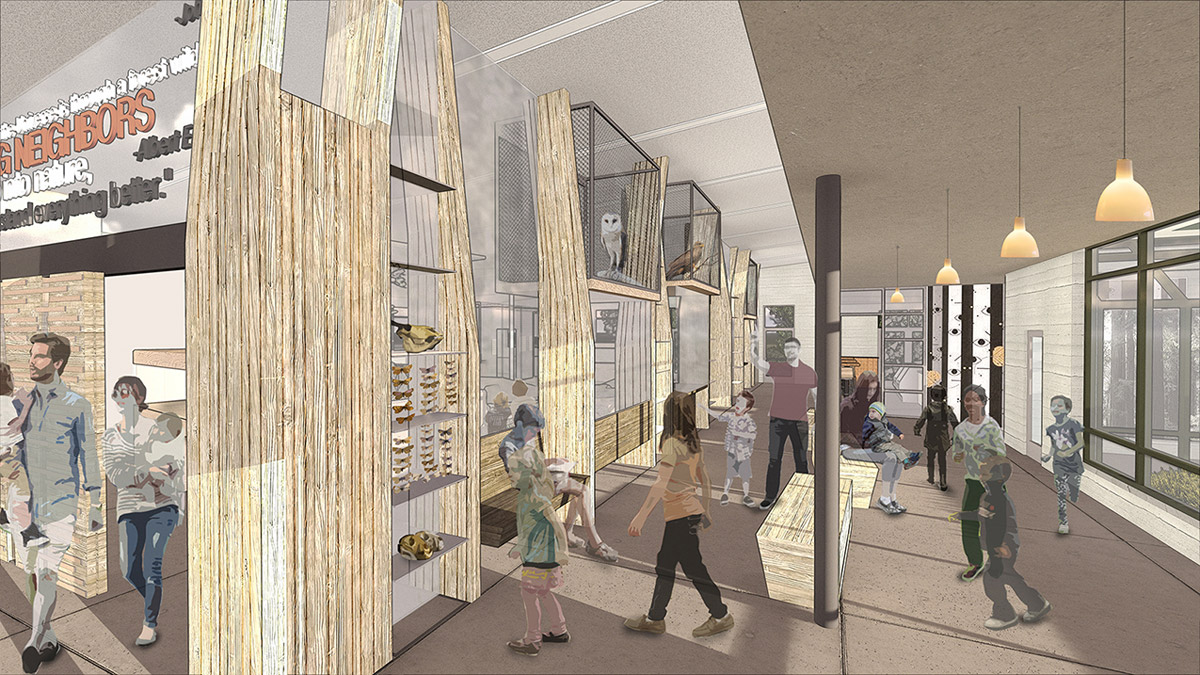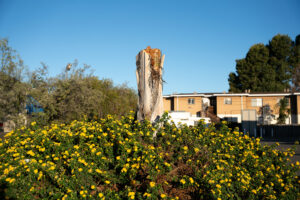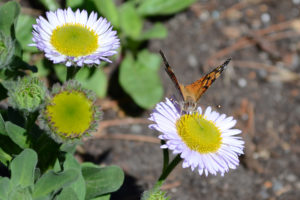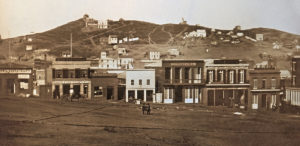t’s moving day at the Randall Museum, and the animals are jittery. Most of the large cages that usually populate the live animal exhibit are gone—instead, the room is filled with the sounds of animalian discomfort. Some loud, frantic scratching comes from a plastic kennel covered by a towel, which contains a crow and a blind raven, both flightless. “They haven’t left the Randall in 30 years, other than to get their nails clipped,” a staffer says.
A robin, sparrow, and cedar waxwing chirp nonstop, flurries of feathers in their cages. The museum’s tail-less raccoon, now housed in the largest wire cage, alternates between performing desperate acrobatics and clawing at its neighbors through the mesh. A rabbit sits stoically in a tiny carrier.
It’s the morning of June 16, just over two weeks after the Randall officially closed for its year-long renovation, and the staff are preparing to move the 50 or so species of animals housed in the museum to their temporary home at Mission Art Center, where summer programs start July 1. The move is orchestrated by science curator Nancy Ellis, who pauses briefly from coaxing animals into small cages to chat. “This was an ordeal,” she says, only half-joking.
The quail have yet to be transferred to smaller cages, so an employee prostrates himself on the floor to grab the fluttering birds (normally demure) and hand them off one by one to another staffer as if they were small, indignant batons. After the quail are safely stowed, the employee retrieves a clutch of speckled eggs.
Soon the carriers and cages and boxes are all loaded onto a gray plastic cart, and Ellis wheels them towards the parking lot. “All right, you guys, this is the big adventure time!” she says (to the animals). “Woo! Big adventure!”
As the cart passes through the museum’s double doors, it bumps over the threshold and jostles the containers. The flapping, scrabbling noises intensify.
Outside, the cages are carefully placed into the waiting truck—the raccoon first, then the tortoises and the rabbits and the chickens and the guinea pigs and the waxwing and everyone else. A scrub jay perched in the trees overhead starts squawking its head off, and doesn’t stop until the van is safely packed and off to Mission Art. The animals won’t return until late next year, when they’ll reanimate a beloved San Francisco institution that plans to do all the same things but with a lot more flair.
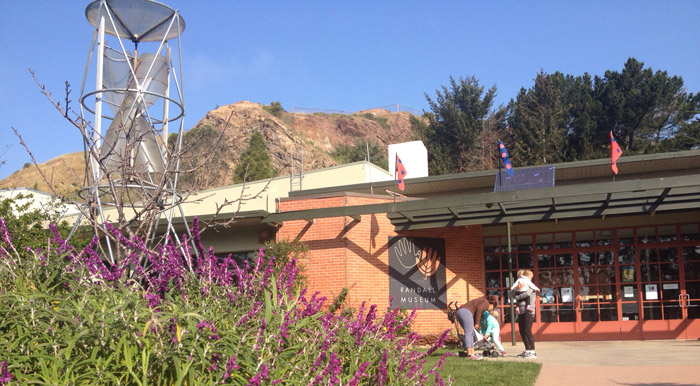
he Randall Museum, the beloved museum perched atop a hill in San Francisco’s Corona Heights, is launching an overhaul of its facilities that will keep it closed to the public until late 2016. In 2010, the Randall Museum Friends and San Francisco Recreation and Park Department, which runs the Museum, jointly applied for and won a $5.5 million grant from the California State Parks. “It was a real turning point for the Randall Museum when we secured those funds,” says Beth Roy Jenkyn, a board member of the Randall Museum Friends. “We were the only institution in San Francisco to win the grant.”
Since the funds only cover a physical remodel, the Randall Museum Friends decided to raise an additional $2.5 million to make sure programming matched the new and improved Randall—money that will go toward new furniture, special machinery, and other equipment.
The Randall building, which opened in 1951, was conceived of and designed by Josephine Randall, San Francisco’s first Superintendent of Recreation, who hiked up to the top of Corona Heights in the 1920s and fell in love with its wildness. “Here was a spot in the very heart of the city,” she wrote, “where our young people could be carried away from the traffic and noise and spend a happy day in the country.”
Randall believed in the value of “purposeful hobbies”—kids making things with their hands—and wanted to establish a children’s museum that would also teach them about environmental stewardship. Today, the Randall is a field trip destination for more than 15,000 children a year, holds arts, ceramics, and woodworking classes for kids and parents alike, and serves as the host of an annual city-wide middle school science fair. It’s also the home of the Golden Gate Model Railroad Club, and a meeting place for the San Francisco Beekeepers Association, the Mycological Society of San Francisco, the San Francisco Amateur Astronomers, and the San Francisco Microscopical Society.
“We’re a swingin’ place!” says Nathan Robinson, administrative director of the Randall Museum Friends.
But the Randall is showing its age, too. The 64-year-old building, complete with a Cold War-era bomb shelter, is filled with dusty classrooms, ancient projectors, chipping paint, linoleum floors, an oddly large number of sinks, and in certain rooms, an upright piano, a rolltop desk, and an old classroom model of a human skeleton.
The new plan opens up a path that winds through the museum, and adds an elevator for accessibility. (“You have no idea there are three stories when you come in,” Robinson says.)
Prominent in the lobby will be a barn door, adorned with tiles bearing the names of donors and decorated by kids. Permanent exhibits will explore topics in California nature, including one on seismology and tectonic plates, one on the ocean (developed in partnership with the Gulf of the Farallones National Marine Sanctuary), and one on the ecology of redwood forests. There may be a fog machine. A spare classroom in the building’s east wing will be converted into a concession area, dubbed Café Josephine, so parents won’t have to trek down the hill for food.
The new exhibits will be stocked, in part, with specimens from the Randall’s collections. Over the years, the museum has amassed a trove of geological and biological specimens, which are currently crammed in two locked rooms in the Randall’s basement. (The basement will also be converted to exhibit space.) One room contains taxidermied animals draped in blue plastic bags—a duck, a skunk, and an irate-looking great horned owl. There’s a selection of large nautilus shells (“Aren’t they beautiful?” says museum Director Chris Boettcher), skulls of various sizes and dentitions stacked on every surface, and one wall filled entirely with drawers of pinned butterflies, corals, sponges and shells. Robinson proudly draws my attention to their sea turtle, while Boettcher takes a moment to marvel at an ornately patterned camp olive shell the size of a human fist. “It’s just an amazing thing,” he says. “How do they know when to produce this pigmentation and when to stop?”
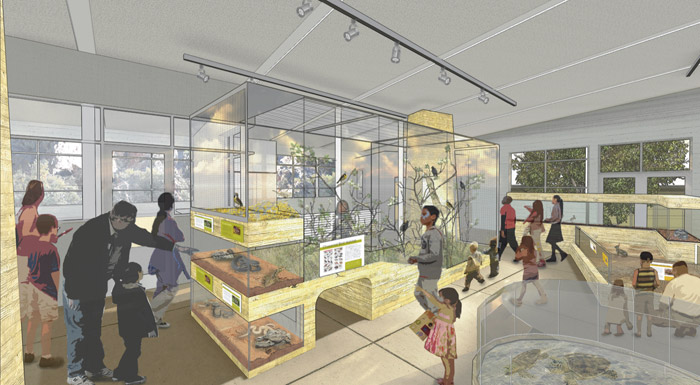
he one truly new part of the revitalization is on the other side of the museum and up one floor, where the woodworking shop has been located. That space instead will get a cutting-edge STEM lab called The Garage, and, as the Randall’s new hub for their engineering, robotics and physics classes, it’ll come stocked with a 3D printer and CNC routers, cutting tools controlled by computers. The Randall plans to develop its STEM programming for older kids and teenagers, an effort to grow up and get with the times. “The Randall presents science in such a hands on, open-ended, exploratory way that to have a dedicated space for STEM is going to be phenomenal,” Jenkyn says. “It’s a natural complement to everything at the Randall—it just takes it one more step into today’s world.”
The Garage represents an embrace of the digital age, but also a recognition of its problems. Boettcher recently attended a conference on the state of STEM education in California, and was troubled by statistics that showed California lagging behind. “The gap between technologically literate segments of the population and those who are unskilled is getting wider,” he wrote in the Randall’s summer brochure. So the museum’s free or low-cost programs become all the more important in narrowing this gap for the city’s kids. “San Francisco is an expensive place for families to live,” Jenkyn says. “To have something where there’s no admission and where the programs are low-cost, it’s a rarity these days.”
But even with all the new-fangled stuff, Boettcher says, “we’ve been very good at doing analog technology for years” — and they have no intention of stopping. “There are some parts of analog technology that we like, that we wouldn’t want to leave behind,” he adds. “The ability to interact directly with tools and materials in a ‘real’ process rather than a ‘virtual’ one is much more personal.”

f course, the Randall’s main attraction is its live animal exhibit, which draws scores of kids every day, petting, pointing, and peppering the animal care staff with questions. “I don’t even think they realize they’re learning,” says Jenkyn, who takes her daughters to the Randall.
On my tour of the museum, I ask if the animals have names. “They do, but we try to avoid publicizing them,” Robinson says. “We don’t want the kids to anthropomorphize the animals.”
I park in front of the raccoon cage and watch as the raccoon pulls wad after wad of brown paper out of a suspended plastic container. It’s only after I see the tails that I realize, with a small thrill of horror, that wrapped in the paper are the carcasses of dead rats, which the raccoon fishes out and bites in half with great relish. I glance at the two toddlers watching next to me. They seem unfazed. If anything, they’re casual about the whole thing—they probably don’t realize they’re learning, either. I never find out the raccoon’s name.
Even if the Randall’s animals are fairly run-of-the-mill and incapable of surviving in the wild, there’s something timeless about watching animals and having them educate you simply by existing. And there’s nothing outmoded about the Randall’s bug hikes or geology classes, where kids explore the outcroppings of red chert that literally surround the museum.
When the Randall opens late next year, it’ll look different. Spiritually, though, it’ll be the same museum that Josephine Randall conceived of back in 1928, a testament to the lasting importance of teaching kids about nature. The remodel isn’t a reinvention, Boettcher says; “It’s what we do now, better.”
And that’s the way Randall supporters want it, Jenkyn says. “Folks want to make sure that certain elements are staying there, like ‘Where’s the bunny going to be?’ and ‘Are you going to still have XYZ?’” she says. “Once they’re sure that all of those things are still going to be there, but even better, people are thrilled.”

